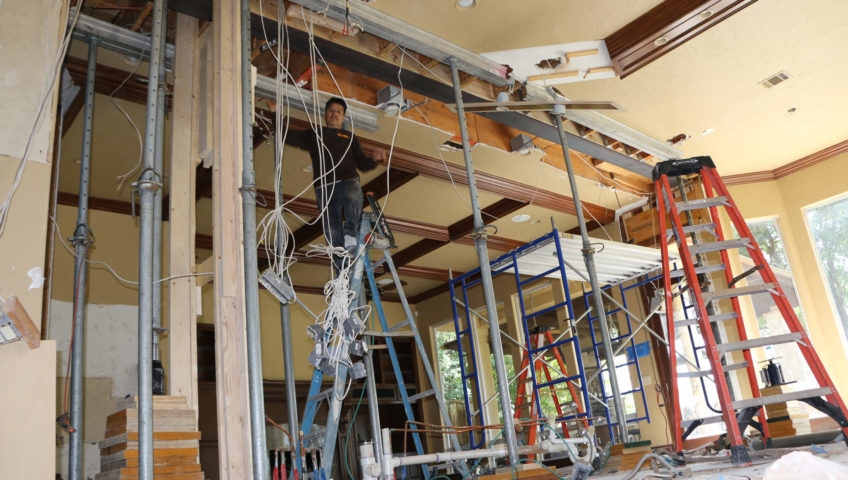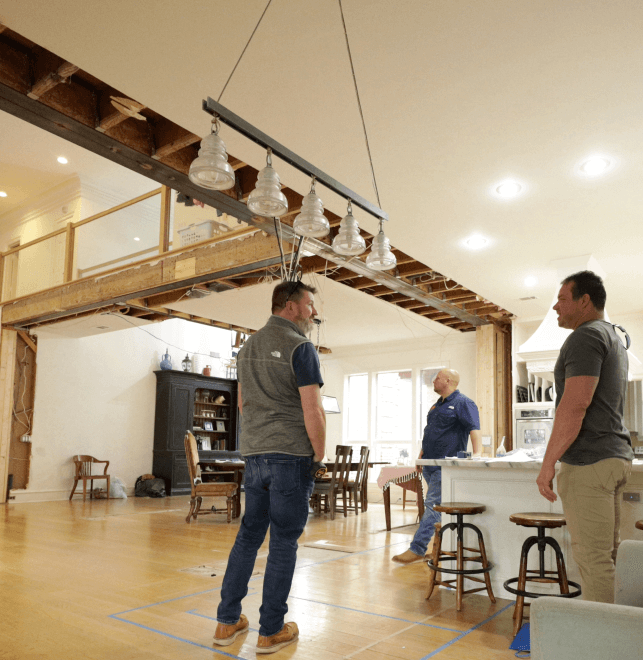
How to Install a Load-Bearing Beam
How to Install a Load-Bearing Beam: A Comprehensive Guide
When undertaking a home renovation project, particularly one that involves opening up your space or removing walls, installing a load-bearing beam becomes an essential task. Whether you want to remove a wall to create an open-plan living area or simply improve the flow of your home, a properly installed load-bearing beam ensures the structural integrity of your house remains intact. However, this is no simple task, and it’s important to approach the project with care and precision.
In this guide, we’ll walk you through the steps to install a load-bearing beam safely and effectively, covering everything from tools to safety measures and expert tips.
Why You Might Need a Load-Bearing Beam
A load-bearing wall plays a crucial role in the stability of your home. It supports the weight of the structure above, including the roof, upper floors, or attic. When you remove a wall for aesthetic reasons or to create a larger space, a load-bearing beam is needed to redistribute the weight. A well-installed beam ensures that the load is transferred to the foundation without compromising the building’s structural safety.
Before You Begin: Safety First!
Installing a load-bearing beam is no small feat and involves working with heavy materials and structural elements. Safety should always be your top priority. Follow these safety precautions before starting:
Wear Protective Gear: Always wear safety goggles, gloves, and steel-toed boots to protect yourself from debris, falling materials, and tools.
Check for Hidden Utilities: Before cutting or drilling, confirm that there are no electrical wires, plumbing, or gas pipes in the wall where you’ll be working. If unsure, consult a professional.
Ensure Structural Support: Before removing any walls, temporarily support the area above using proper shoring or jacks to prevent accidental collapse.
Work with a Partner: Installing a heavy beam requires coordination, so enlist help if possible. Handling large beams alone can be dangerous.
Step 1: Gather the Tools and Materials You’ll Need
Before you begin, ensure you have the necessary tools and materials. Here’s a list of what you’ll need for the job:
Tools:
Measuring Tape: To measure the length and height of the area.
Hammer and Nails or Screws: For securing temporary supports.
Circular Saw: To cut any materials (if needed).
Drill: For drilling holes and securing beams.
Level: To ensure the beam is properly aligned and level.
Shoring or Jacks: To support the structure above during installation.
Lifting Equipment: A hoist or crane for heavier beams.
Materials:
Load-Bearing Beam: Steel or wood, depending on the required strength and your project.
Support Posts: These will be placed under the beam for added support.
Fasteners: Bolts, nuts, or heavy-duty screws designed for structural applications.
Shims: Used to level the beam if necessary.
Step 2: Plan and Measure
The first step is to assess the area where the load-bearing beam will go. Measure the distance between supports, the length of the wall, and the height of the opening.
Key Measurements:
Width of the opening: The beam needs to cover the entire width of the opening and carry the load from the structure above.
Beam Height: The beam must fit within the space available above the opening while still providing adequate support.
Load Calculations: Calculate the weight that the beam will need to support. You may need to consult an engineer for this, especially if your home has multiple floors or heavy roofing.
Step 3: Temporarily Support the Structure
Before removing the load-bearing wall, it is crucial to ensure that the upper structure is properly supported. Use temporary supports, such as adjustable jacks for shoring, on both sides of the wall.
Place the Jacks: Position adjustable jacks or posts under the floor joists or ceiling beams directly above the wall. Ensure that they are secure and capable of bearing the weight of the structure above.
Check Alignment: Use a level to ensure the supports are evenly placed and stable.
Step 4: Remove the Wall and Prepare the Opening
Once the structure is temporarily supported, you can proceed to remove the wall. Depending on your project, this could involve:
Demolishing the Wall: Use a sledgehammer or circular saw to remove the wall. Ensure that any remaining drywall or studs are properly cut out.
Preparing the Opening: Clean up any debris and prepare the area where the beam will be placed. This may include removing any remaining framing material to create a clean space for the new beam.
Step 5: Install the Load-Bearing Beam
Now comes the critical part: installing the load-bearing beam.
Position the Beam: With the help of a partner or lifting equipment, carefully position the beam into place. Ensure that it is level and correctly aligned with the supports.
Secure the Beam: Use heavy-duty bolts or screws to fasten the beam to the support posts. Make sure that the beam is firmly secured at both ends to the foundation or the adjacent structural elements.
Shim the Beam: If needed, place shims under the beam to ensure that it is level. A level should be used at every stage to make sure the beam is perfectly aligned.
Step 6: Recheck Alignment and Finish
Once the beam is in place, double-check that everything is level and secure. Ensure that the beam is adequately fastened and that the load is distributed evenly.
Remove Temporary Supports: Once the beam is installed and secured, carefully remove the temporary supports. Make sure that the beam is bearing the weight before fully removing them.
Reinforce the Beam: If necessary, reinforce the beam with additional supports or framing elements, especially if the load is substantial.
Step 7: Final Inspections and Safety Checks
After installation, conduct a thorough inspection to ensure that everything is secure and aligned properly. It’s always a good idea to have a structural engineer or professional contractor assess the work if you’re unsure.

When to Call a Professional
While installing a load-bearing beam can be a DIY project for some, it’s important to recognize when you need professional help. Here are some instances where you should contact a contractor or structural engineer:
Permitting and Code Compliance: A professional will know the local building codes and handle the necessary permits.
Heavy or Complex Beams: For larger, more complicated beams, such as steel, a professional may be required for installation.
Structural Concerns: If you’re unsure about the structural integrity or load calculations, it’s best to consult with an expert.
Cost Breakdown: Understanding the Investment
Before diving into the project, it’s important to consider the costs involved. While the price of installing a load-bearing beam can vary based on the complexity of the job, the materials used, and whether you hire a professional or tackle the task yourself, here’s a rough breakdown of the costs you can expect:
Material Costs:
Wooden Beams: On average, a standard wooden load-bearing beam can cost anywhere from $100 to $500 per linear foot, depending on the quality and type of wood.
Steel Beams: Steel beams tend to be more expensive, with prices ranging from $300 to $700 per linear foot, depending on the size and grade of steel.
Support Posts: Heavy-duty support posts typically cost between $50 to $150 each.
Labor Costs:
If you decide to hire a professional contractor, the cost of labor can be significant, especially if the job requires custom steel beams or extensive structural work. Labor rates generally range from $50 to $100 per hour, and the project may take a few days to complete, depending on its complexity.
Total Estimate:
For a DIY job, you can expect to pay $500 to $2,000 for materials, depending on the beam type and the size of the opening.
Hiring professionals can push the cost to $2,000 to $10,000 or more, depending on the complexity of the installation and the need for specialized equipment or engineering.

Tips for Choosing the Right Beam
Choosing the right type of beam is crucial to ensuring that the load-bearing function is achieved. Here’s what you should know:
Wood vs. Steel:
Wood is typically used for smaller spans and lighter loads. It’s cost-effective and easier to work with, but it may not be suitable for larger openings.
Steel is often the preferred choice for larger spans and heavier loads because of its superior strength and durability. However, it is more expensive and may require special tools for installation.
Beam Sizing:
Proper sizing is critical to ensure the beam can support the load. The size of the beam depends on factors like the span, the weight it needs to carry, and the type of material used. If you’re unsure, it’s advisable to consult a structural engineer.
Post-Installation Tips
Once your load-bearing beam is in place, you’ll want to ensure it stays in top condition:
Check for Settling: Over time, the beam may settle slightly. It’s important to monitor the installation in the weeks following the project to ensure there are no issues with the beam shifting or sagging.
Aesthetic Finishes: If you’re leaving the beam exposed, you may want to consider finishing it with paint or a wood stain to match your home’s décor. For steel beams, you can add a protective coating to prevent rusting.

Common Issues and Troubleshooting
During installation, you may encounter some challenges. Here’s how to address common issues:
Beam Warping: Wooden beams, especially if they’re not properly treated or sealed, can warp over time. Ensure your beam is made from high-quality, treated wood. If warping occurs, consult a professional to see if additional support is needed.
Structural Instability: If your temporary supports aren’t holding up the load properly, it may be necessary to reinforce them with additional posts or jacks to prevent damage during installation.
Local Building Codes and Regulations
Always check with your local authorities about the building codes and permit requirements for installing a load-bearing beam. Some regions require a structural engineer’s report or approval before you can proceed with the installation. To find out what’s required in your area, visit your local government’s building department or consult with a professional contractor.
When to Call a Professional
While DIY installation is possible, there are certain situations when hiring a professional is a must:
Permitting and Code Compliance: If you’re unsure about the required permits or building codes, a contractor can guide you through the process.
Large or Complex Beams: For larger spans or when using steel beams, a professional may be necessary to ensure the beam is properly sized and installed.
Structural Integrity Concerns: If you have doubts about the safety or load calculations, hiring a structural engineer can prevent costly or dangerous mistakes.
Your Next Steps
Once the beam is in place, you can start envisioning the new open space in your home. Don’t forget to patch up any drywall, trim, or flooring that may have been disrupted by the installation.
After the beam is installed, you’ll be left with a solid, open area that is structurally sound and aesthetically appealing. If you’re considering further renovations, such as installing custom cabinetry or creating an open-plan layout, now is the perfect time to consult with an interior designer.
If you’re unsure about any part of the process, or if you encounter problems along the way, remember that professional help is always available. Whether you’re reinforcing the beam, adding finishing touches, or addressing unforeseen issues, a contractor or structural engineer can help you achieve the best results.

FAQ Section
Can I install a load-bearing beam without a permit?
In most areas, a permit is required for installing a load-bearing beam, as it’s a structural change to your home. Always check with your local authorities before proceeding.
How do I know if my beam is the correct size?
Beam sizing depends on various factors like the span and load. It’s best to consult with a structural engineer to ensure the beam is properly sized.
What if my floor joists are not aligned with the beam placement?
If your floor joists aren’t aligned, additional framing may be required to support the beam properly. A professional contractor can assist with this.



